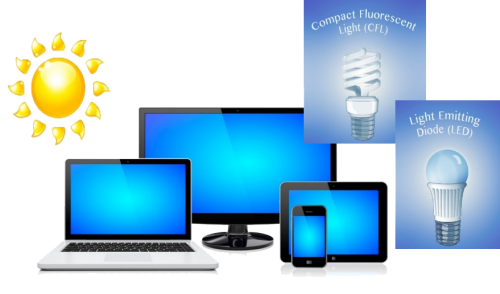Light Beyond UV:
- Blue high energy visible (HEV) light
and
- Infrared (IR) light
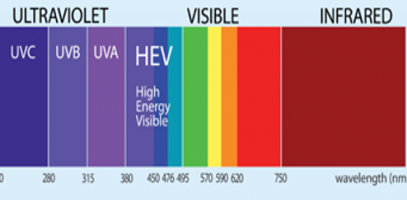
HEV and IRA light penetrate deeper in the skin than the UV rays
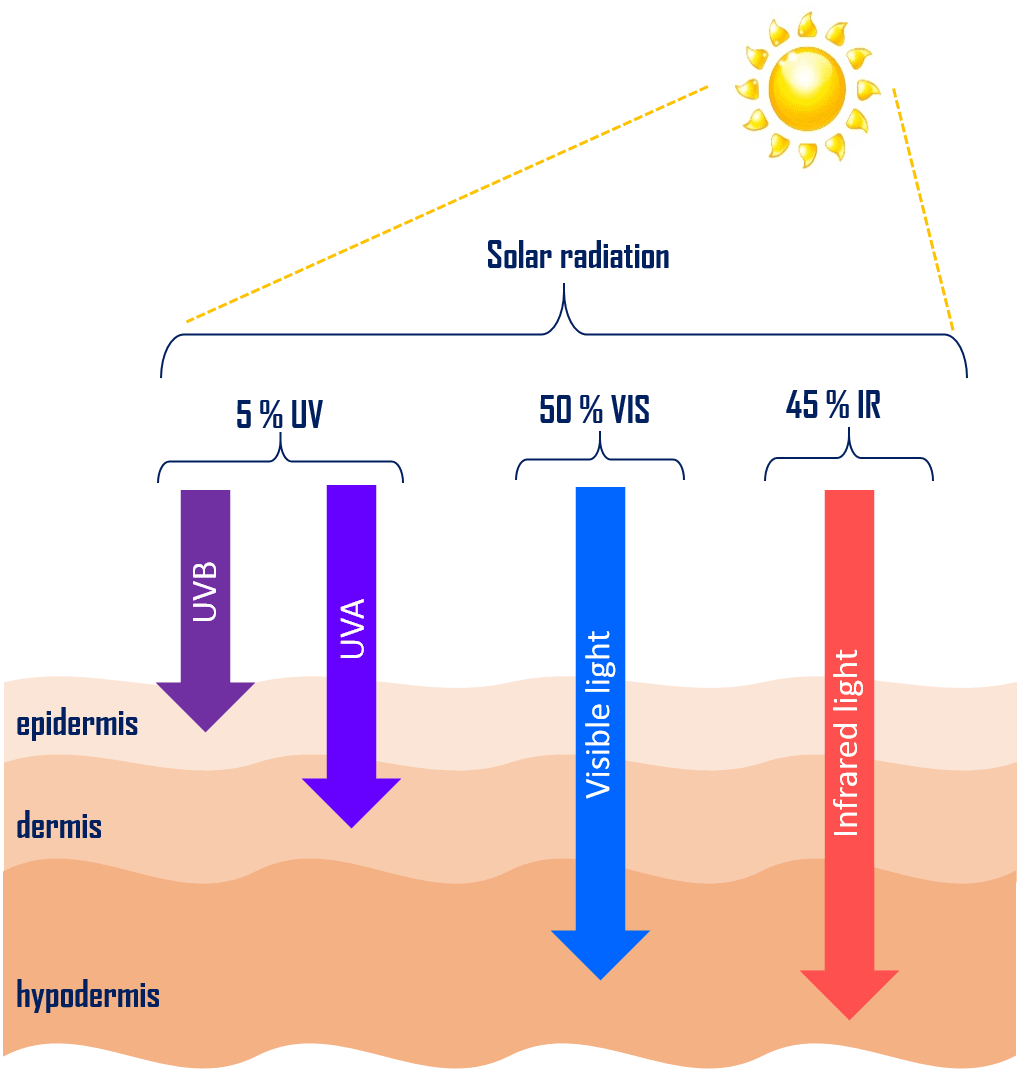
NOTE: The relative abundance of HEV and IR light in the Solar radiation and their deeper penetration in the skin are most likely to have long term consequences on the skin health and skin appearance.
Light Beyond the UV is Damaging the Skin
Scientific evidence shows that the non-UV light affects the skin health and skin appearance mainly via generation of free radicals and oxidative stress resulting in premature skin aging and increased risk of skin cancer.
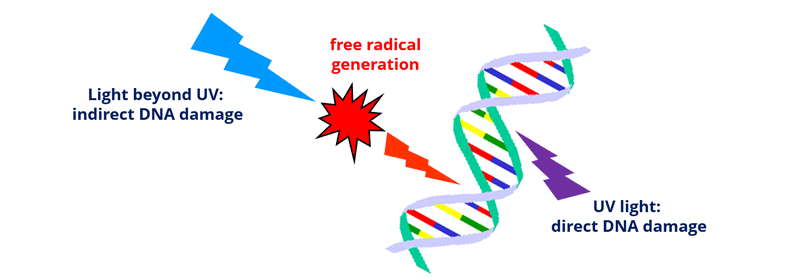
HEV and IRA light have been also associated with induced skin inflammation, immuno-suppression, hyper-pigmentation, elastosis and collagen breakdown.
CSI Technology Offering Protection Beyond UV
- CSI active ingredients and formulations, majority of them of natural and organic origin, provide tunable light shielding in HEV spectral range.
- CSI formulations exhibit pronounced antioxidant capability to
- prevent the generation of new free radicals and
- neutralize wide spectrum of already existing free radicals.
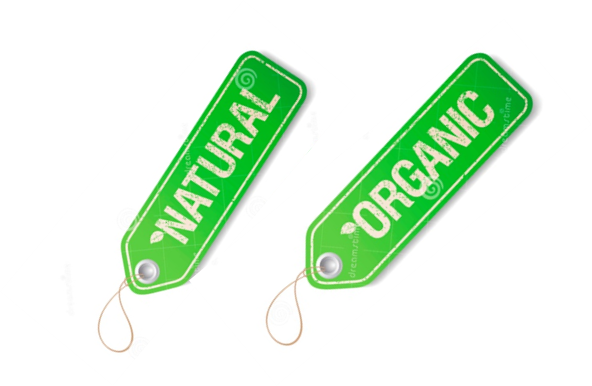
CSI Light Shielding vs. Commercial Sunscreens

UV-VIS absorption spectra of CSI formulations and commercial sunscreens.
CSI formulations extend the protection range beyond UV
CSI Antioxidant (Free-Radical-Scavenging) Activity
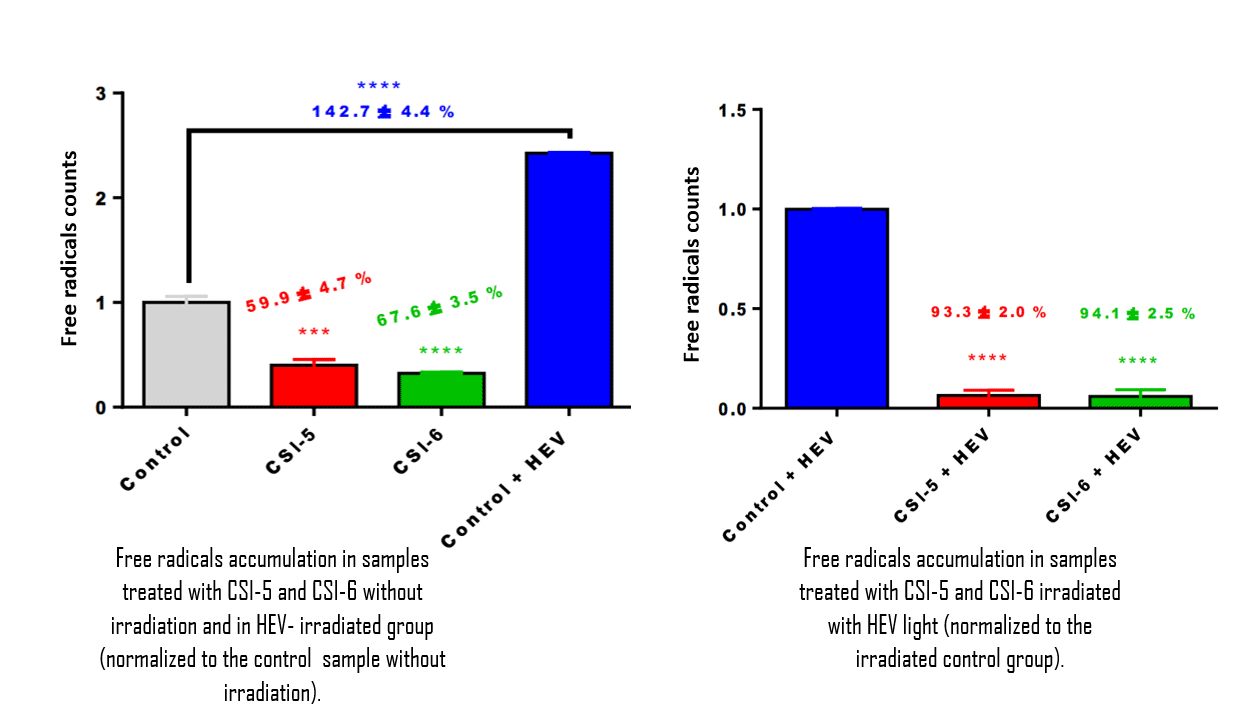
in vitro tests:
- Exposure of a model cell system with a strong blue LED light significantly increases the free radical level by 143 % compared to the control group.
- When the model cell system (without being irradiated) was treated with CSI-5 and CSI-6 formulations, the formulations displayed strong antioxidant activity decreasing the free radical level by 60-70 %.
- When the model system was treated with the CSI-5 and CSI-6 formulations and irradiated with strong blue LED light, the results showed that CSI-5 and CSI-6 decreased the free radicals level generated by the blue light exposure by 93 % and 94 %, respectively.
CSI formulations protect from new-generated free radicals due to the blue light exposure.
CSI Technology Offering Protection Beyond UV
CSI’s IP covers antioxidant compositions for protection beyond UV.


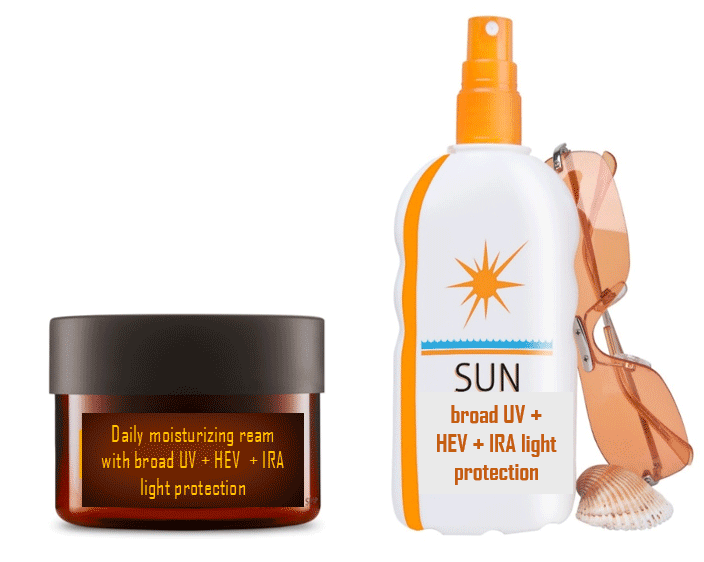
References
- S.Q. Wang, H.W.Lim (Eds), Principles and Practice of Photoprotection, Springer International Publishing, 2016.
- E. Dupont, J. Gomez and D. Bilodeau, Beyond UV radiation: A skin under challenge, Int. J. Cosm. Sci., 2013, 1–9.
- P. Schroeder et al. Photoprotection beyond UV irradiation – Effective sun protection has to include protection against IRA radiation-induced skin damage, Skin Pharmacol. Physiol. 2010, 23, 15-17.
- L. R. Sklar et al. Effects of ultraviolet radiation, visible light, and infrared radiation on erythema and pigmentation: a review, Photochem. Photobiol. Sci., 2013, 12,54–64.
- S. Grether-Beck et al., Photoprotection of human skin beyond ultraviolet radiation, Photodermatol Photoimmunol & Photomed2014; 30: 167–174.
- Zastrow et al. Light – instead of UV protection: new requirements for skin cancer prevention, Anticancer Research 36: 1389-1394 (2016)
- G. Monfrecola et al., The effect of visible blue light on the differentiation of dendritic cells in vitro, Biochimie 101 (2014) 252-255.
- S. Vandersee et al. Blue-Violet Light Irradiation Dose Dependently Decreases Carotenoids in Human Skin, Which Indicates the Generation of Free Radicals, Oxidative Medicine and Cellular Longevity, 2015, Article ID 579675.
- F. Liebel et al., Irradiation of Skin with Visible Light Induces Reactive Oxygen Species and Matrix-Degrading Enzymes, Journal of Investigative Dermatology (2012) 132, 1901–1907.
- M. F. Holick, Biological Effects of Sunlight, Ultraviolet Radiation, Visible Light, Infrared Radiation and Vitamin D for Health, Anticancer Research, 36: 1345-1356 (2016).
- M. M. Kleinpenning et al., Clinical and histological effects of blue light on normal skin, Photodermatology, Photoimmunology & Photomedicine, 26, 16–21, 2010.
- C. Opländer et al., Effects of blue light irradiation on human dermal fibroblasts, Journal of Photochemistry and Photobiology B: Biology 103 (2011) 118–125.
- J. Liebmann et al., Blue-Light Irradiation Regulates Proliferation and Differentiation in Human Skin Cells, Journal of Investigative Dermatology (2010) 130, 259–269.
- Zastrow L. et al. UV, visible and infrared light. Which wavelengths produce oxidative stress in human skin?,Hautarzt 2009 · 60:310–317
- A. Mamalis et al. Light Emitting Diode-Generated Blue Light Modulates Fibrosis Characteristics: Fibroblast Proliferation, Migration Speed, and Reactive Oxygen Species Generation, Lasers in Surgery and Medicine 47:210–215 (2015).
- C. Opländer et al, Mechanism and biological relevance of blue-light (420–453 nm)-induced nonenzymatic nitric oxide generation from photolabile nitric oxide derivates in human skin in vitro and in vivo, Free Radical Biology and Medicine 65 (2013) 1363–1377.
- L. Kolbe, How Much Sun Protection Is Needed?: Are We on the Way To Full-Spectrum Protection?, The Journal of Investigative Dermatology (2012), Volume 132, 1756-1757.
- Robert, C. et al. Low to moderate doses of Infrared A Irradiation impair extracellular matrix homeostasis of the skin and contribute to skin photodamage, Skin Pharmacol. Physiol. 2015, 28, 196-204.
- P.Schroeder et al. Infrared Radiation-Induced Matrix Metalloproteinase in Human Skin: Implications for Protection, Journal of Investigative Dermatology (2008) 128, 2491–2497.
- Mi-Sun Kim et al Regulation of type I procollagen and MMP-1 expression after single or repeated exposure to infrared radiation in human skin, Mechanisms of Ageing and Development 127 (2006) 875–882
- L. Knels et al. Effects of Narrow-band IR-A and of Water-Filtered Infrared A on Fibroblasts, Photochemistry and Photobiology, 2016, 92: 475–487
- Daniel Barolet et al., Infrared and skin: Friend or foe, Journal of Photochemistry & Photobiology, B: Biology 155 (2016) 78–85
- C-H. Lee et al. Differential immunological effects of infrared irradiation and its associated heat in vivo, Journal of Photochemistry & Photobiology, B: Biology 155 (2016) 98–103
- S. Cho et al. Effects of Infrared Radiation and Heat on Human Skin Aging in vivo, Journal of Investigative Dermatology Symposium Proceedings (2009) 14, 15–19
- Christian Calles et al. Infrared A Radiation Influences the Skin Fibroblast Transcriptome: Mechanisms and Consequences, Journal of Investigative Dermatology (2010) 130, 1524–1536
- A. M. Holzer et al. The Other End of the Rainbow: Infrared and Skin, J Invest Dermatol. 2010; 130(6): 1496–1499.
- P. Schroeder, J. Krutmann., IRA protection. Needs and possibilities, Hautarzt 2009 · 60:301–304
- M. Rinnerthaler, et al. Oxidative Stress in Aging Human Skin Biomolecules 2015, 5, 545-589.
- B. Poljsak, et al. Skin cancer, free radicals and antioxidants, Inter Journal of Cancer research and Prevention, Vol 4, No 3, 2011
- L. S. Kozina et al. Role of Oxidative Stress in Skin Aging, Advances in Gerontology, 2013, Vol. 3, No. 1, pp. 18–22
- H. Masaki, Role of antioxidants in the skin: Anti-aging effects, Journal of Dermatological Science 58 (2010) 85–90
- Lucy Chen et al., The role of antioxidants in photoprotection: A critical Review, J Am Acad Dermatol 2012;67:1013-24
Create. Solve. Innovate. ®
Let us help you connect the dots …

…and reach the target.
Whatever your target is – a novel product, a proprietary formulation,
a new technology, or just a process step improvement, contact us to help you differentiate it from the rest!


